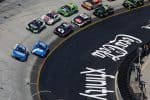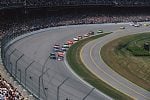Today, SAFER barriers are a staple at every track that any NASCAR national touring series competes on. But the concept of energy absorbing barriers has existed long before the “soft walls” that we know became commonplace.
Some of the first tracks to use such methods were, in large part, road courses. Prominent road course circuits across the world had used barriers made of used tires for decades. Often, those were coupled with paved or gravel runoff areas and large blocks of Styrofoam. Watkins Glen International was one such facility, with its pair of long, fast straightaways that made it almost desperate for a way to slow cars if they go off of the track.
Turn 1 at Watkins Glen is a 90-degree right turn that runs downhill and comes at the end of the lengthy frontstretch. It’s a common passing zone as drivers try to out-brake each other. This can lead to contact and spins, making it a perfect place to put a gravel trap to slow any wayward cars as well as stacks of large foam blocks to cushion a potential impact. During the 2000 race season, the steel barrier outside of turn 1 was lined with a layer of tires, which were then protected by the massive foam blocks.
At the time, Jimmie Johnson was a 24-year-old rookie in the NASCAR Xfinity Series. He had made three starts in that division in 1998, following it up with five more in 1999. Then came a full-time run at Rookie of the Year in 2000, with mixed results early on. Johnson didn’t run the season opener at Daytona International Speedway but had finished a career-best sixth at South Boston Speedway in mid June.
The team he drove for, Herzog Motorsports, wasn’t championship caliber, but consistent top-15 runs and potentially pulling off a surprise victory were certainly within the realm of possibility. Johnson sat 14th in points coming into the event, which served as the start of the second half of the 32-race schedule.
Like many young drivers, Johnson was trying to make a name for himself to catch the attention of the NASCAR community by performing in a manner that would leave everyone stunned. On June 25 at Watkins Glen, the El Cajon, Calif. native did exactly that, albeit not in the way he would have preferred.
After starting 12th, the No. 92 Alltel Chevrolet was having a stellar day, running as high as fourth just past the midway point of the race. On lap 43, Johnson made a pit stop where the crew changed four tires and added fuel. Everything seemed to be in good order with the car as he rejoined the race in 10th position.
Two laps later, the television broadcast returned from a commercial break to the sight of Johnson’s car buried in the turn 1 foam barrier from the nose all the way back to the rear tires. As rescue personnel poured over the car, the commentators emphasized that it had been a rather violent collision, but even that description seemed to fall short once the replay was shown.
As he approached turn 1, the car veered off of the groove down to the inside of the track and shot through the grass. The bumps in the turf essentially launched the car over most of the gravel trap, and it hit the foam barrier with such force that foam chunks were sent more than 50 feet into the air.
Stunned that he was not only alive but apparently unhurt, the crowd seated in the grandstands overlooking the turn erupted in applause when Johnson emerged from his car. Johnson later admitted that he too was surprised by his good fortune and stood atop the car with both arms in the air, jubilant just to be able to celebrate at all.
The Xfinity Series and the sport as a whole were still reeling from the death of Adam Petty in a practice crash at New Hampshire Motor Speedway just six weeks earlier, and for many, this was the first exceptionally violent impact they had seen since. The tension was palpable, as was the relief when Johnson climbed out, ending the dread that he may have encountered a similar fate.
In his interview after he emerged from the infield care center, Johnson said, “That was unbelievable. We came out of the pits, getting up to speed, and I went off into the braking zone in turn 1. I was on the brakes and the pedal went to the floor. At that point I was trying to look for something to run into that would slow me down.”
Johnson went on to add, “I was real fortunate for everybody at Watkins Glen to take the precautions to put that Styrofoam out there, because if it was anything else, I don’t know where I’d be. Probably be in the ambulance going somewhere.”
The crash was a stunning visual and became a fixture on sports highlight shows for days. It even made the ESPN SportsCenter Top 10, complete with Johnson’s victorious reaction. By the time the clip had made the rounds, Johnson was widely recognized as the driver that escaped the harrowing ordeal.
Years later, Johnson reflected on the collision, remarking, “That Watkins Glen Xfinity crash in 2000 was a pretty frightening day. One of the very few times in a racecar that I thought it was over. Brakes went to the floor, I’m bouncing through the grass and I saw the wall. I thought it was a concrete wall and I thought that was it.”
Thankfully, that wasn’t it for Johnson, as he went on to enjoy a legendary career. That said, all of his impressive accomplishments make it easy to overlook how close he came to serious injury or worse, and how different NASCAR history might have been if not for a few blocks of foam.
Frank Velat has been an avid follower of NASCAR and other motorsports for over 20 years. He brings a blend of passionate fan and objective author to his work. Frank offers unique perspectives that everyone can relate to, remembering the sport's past all the while embracing its future.
Follow along with @FrankVelat on Twitter.




